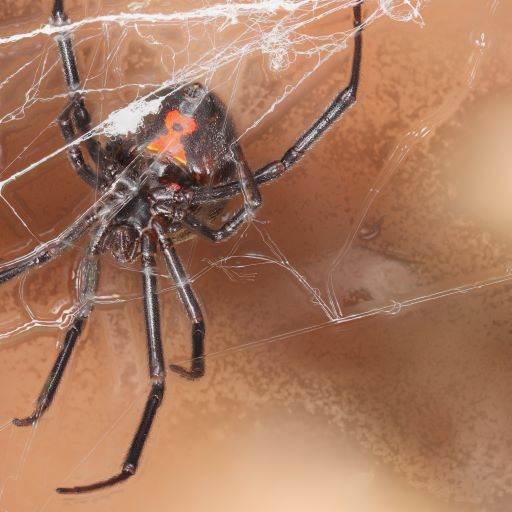Black Widows in Montana (Latrodectus hesperus)
The western black widow, Latrodectus hesperus, is present throughout Montana.
Description

Fig. 1: Black widow female hanging upside down in her web. Photo by Lauren Kerzicnik
The mature female, ½ inch (13 mm), is jet black with a red hourglass on the underside of the abdomen (Figure 1). The adult male is smaller, a lighter brown color, has several white stripes along the abdomen, and is approximately 1/3-inch (8 mm) in size. Immature black widows can range in color from brown to black and will have a longitudinal red stripe along the dorsal portion of the abdomen; all immatures, males, and females have an hourglass shape on the underside of the abdomen.
Black Widow Behavior
- They hang upside down in their tangle-shaped webs.
- Black widows are very timid and are more likely to escape than to try and bite.
- Bites can occur if pressing down on the spider or reaching into its retreat. Otherwise, they are not aggressive.
- Seek medical attention for a suspected bite.
Medical Importance and Venom of Black Widows
Black widow venom contains a neurotoxin called alpha-latrotoxin, affecting the neuromuscular
and central
nervous system. The initial bite is often unnoticed or not painful; it is usually
felt within the first 10 to 60
minutes. The symptoms start in the lymph nodes. Strong muscle cramps develop within
the abdominal region
and these muscles become rigid. Contorted facial expressions, profuse sweating, swollen
eyelids, and inflamed
lips are other common symptoms. These symptoms can last for up to five days and the
recovery can take several
weeks.
Management
Non-Chemical Control
- Modification of any of the habitat surrounding the home is critical to keep spiders
from entering. Eliminate
any potential burrowing sites close to the entrance of the home, including wood piles, rock piles, brush, and
firewood. - Install door sweeps, and seal cracks and crevices around home entrances and the foundation.
Spiders can
also be removed by vacuuming. Vacuum around window wells and other entrances to reduce potential prey
sources and any webs that are created. - Sticky traps can be placed around home entrances and areas where spiders reside including
crawl spaces,
bathrooms, and basements. Reduce clutter in these areas to eliminate potential hiding spots.
Chemical Control
Insecticides labeled for indoor use (mostly pyrethroids, such as those with the active
ingredients bifenthrin,
permethrin, and cyfluthrin) can be used as a last resort to control spiders if large
numbers are present within the
home. Bug bombs are not efective for controlling spiders in the home and are not recommended.
Sprays can
be used outdoors where spiders might be entering, targeting areas around entrances,
including doors, windows,
vents, and garages.
To learn more about the topics discussed on this page, contact the Schutter Diagnostic Lab. If you suspect an infestation on your property, contact your local extension agent, the Schutter Diagnostic Lab at Montana State University, or the Montana Department of Agriculture.
This October 2022 fact sheet is also available as a printable PDF (154KB).
Disclaimer: These recommendations are provided only as a guide. It is always the pesticide applicator’s responsibility, by law, to read and follow all current label directions for the specific pesticide being used. The authors and Montana State University assume no liability resulting from the use of these recommendations. The Montana State University Extension Service is an ADA/EO/AA/Veteran’s Preference Employer and Provider of Educational Outreach.
